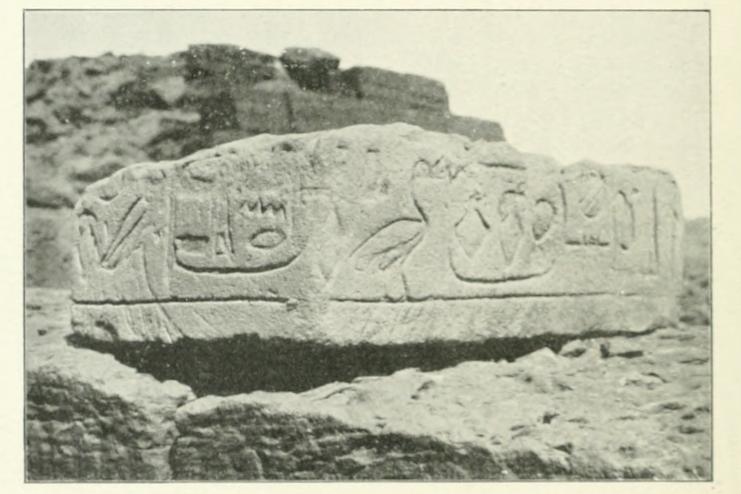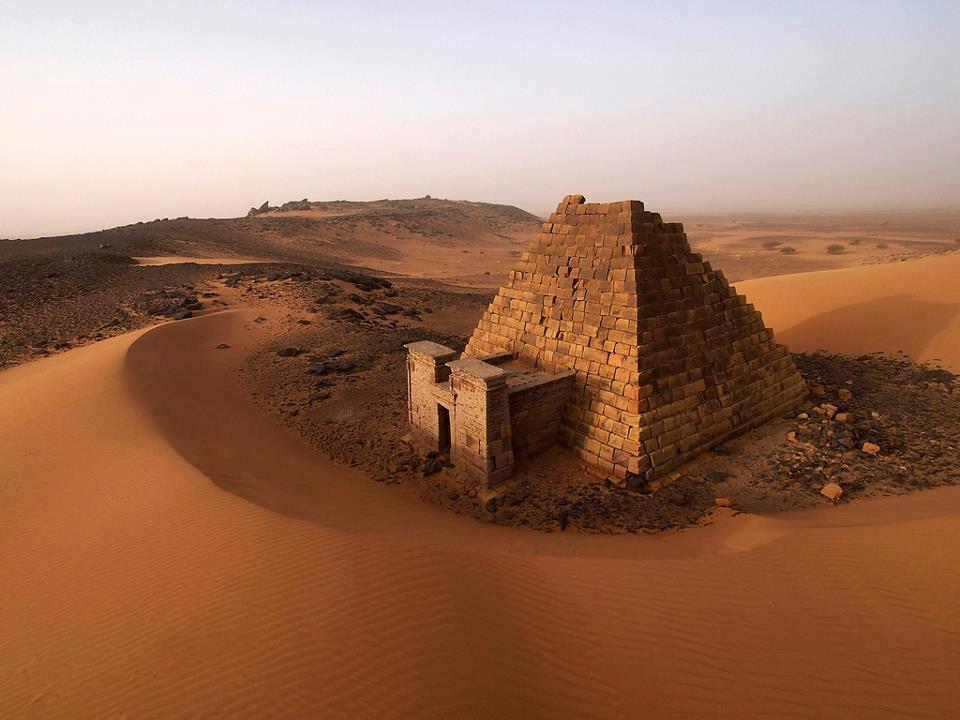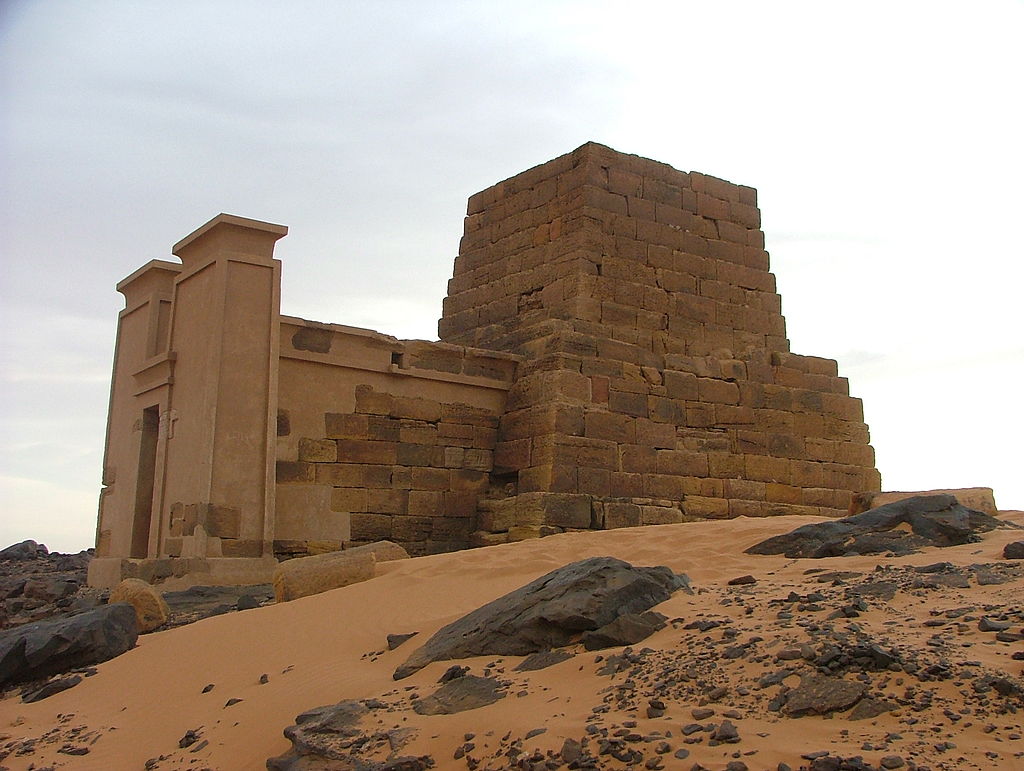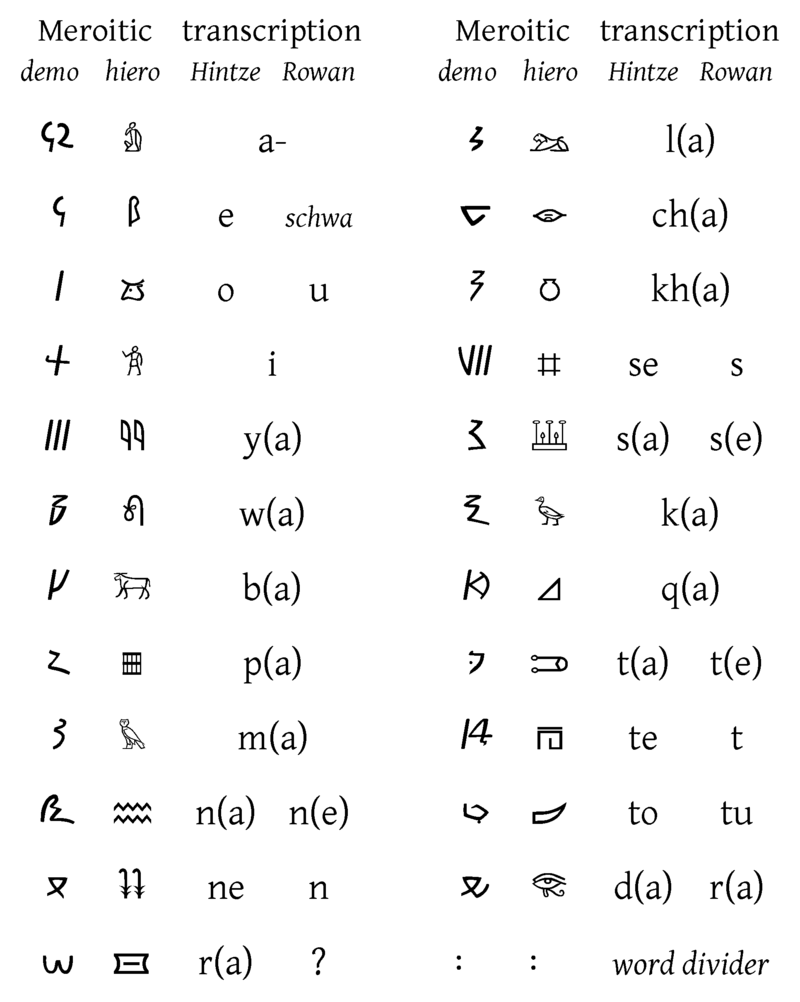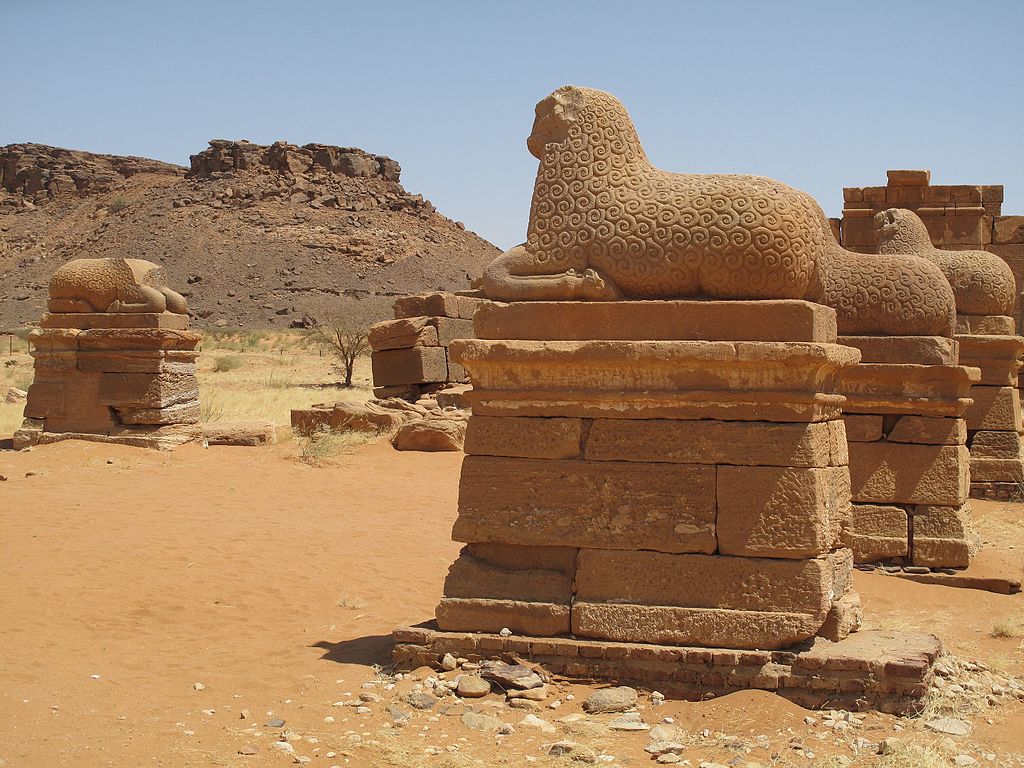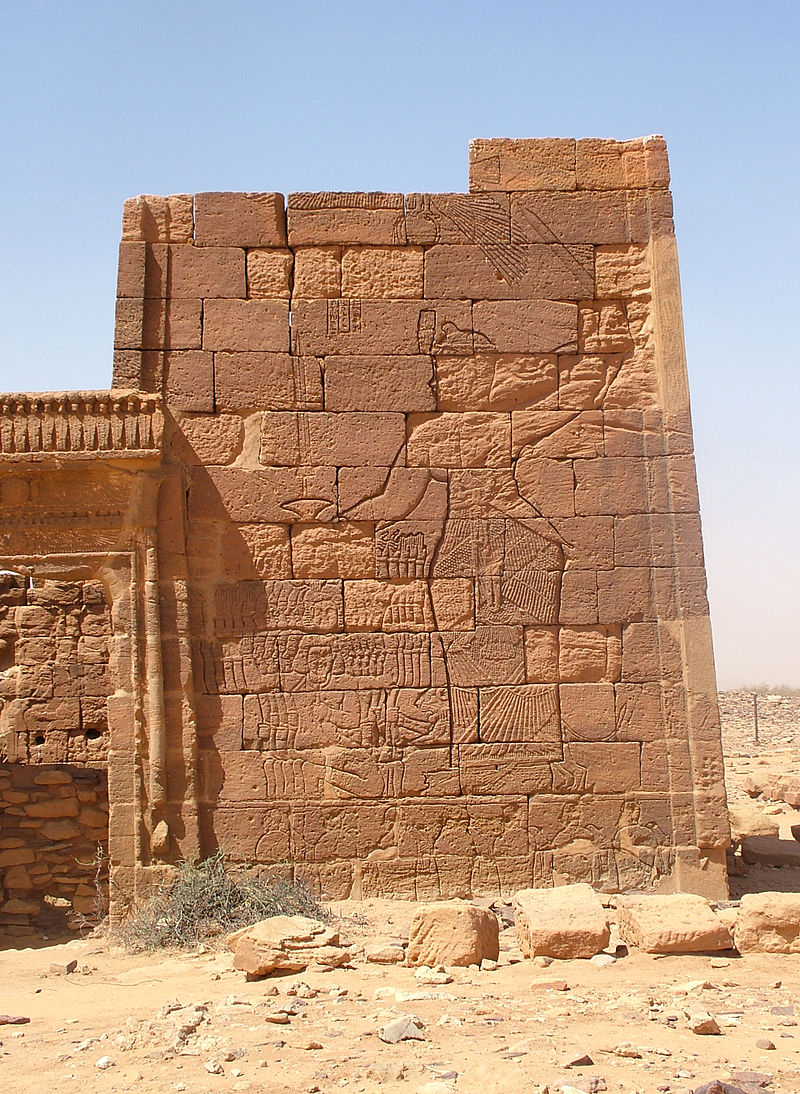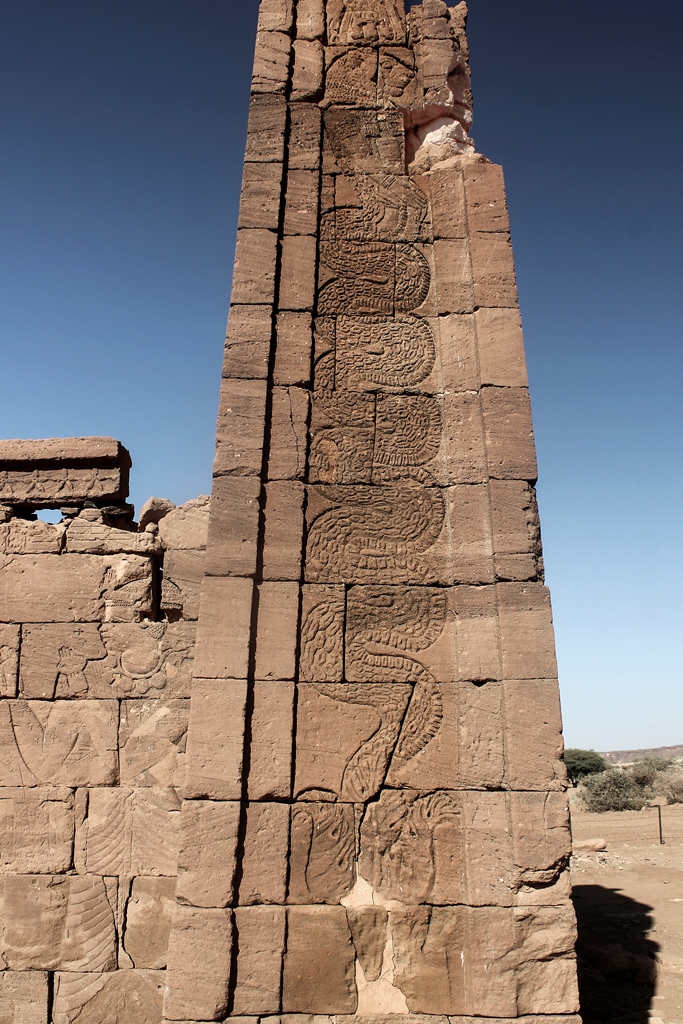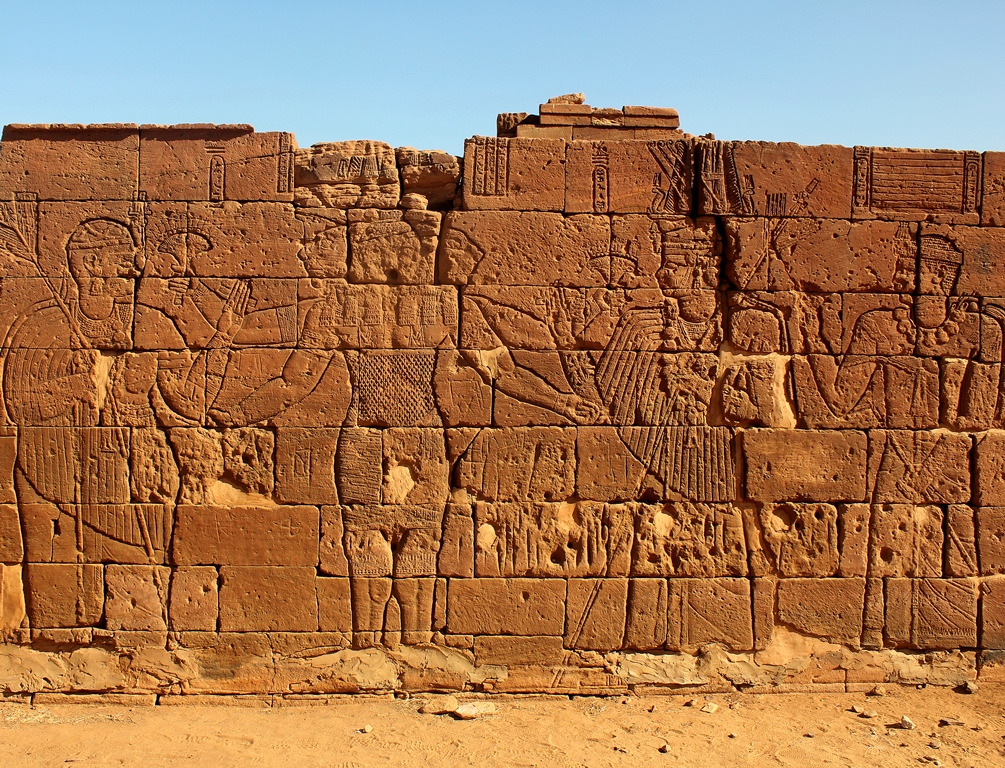Meroë
- Meroë is an ancient city on the east bank of the Nile about 6 km north-east of the Kabushiya station near Shendi, Sudan. This city was the capital of the Kingdom of Kush for several centuries. The Kushitic Kingdom of Meroë gave its name to the Island of Meroë, which was the modern region of Butana, a region bounded by the Nile (from the Atbarah River to Khartoum), the Atbarah and the Blue Nile.
- The city of Meroë was on the edge of Butana and there were two other Meroitic cities in Butana: Musawwarat es-Sufra and Naqa.
- The site of the city of Meroë is marked by more than two hundred pyramids in three groups, of which many are in ruins. They have the distinctive size and proportions of Nubian pyramids.
- Meroë was the south capital of the Napata/Meroitic Kingdom, that spanned the period c. 800 BCE – c. 350 CE. According to partially deciphered Meroitic texts, the name of the city was Medewi or Bedewi. Excavations revealed evidence of important, high ranking Kushite burials, from the Napatan Period (c. 800 – c. 280 BCE) in the vicinity of the settlement called the Western cemetery.
- The culture of Meroë developed from the Twenty-fifth Dynasty of Ancient Egypt, which originated in Kush. The importance of the town gradually increased from the beginning of the Meroitic Period, especially from the reign of Arakamani (c. 280 BCE) when the royal burial ground was transferred to Meroë from Napata (Gebel Barkal).
- In the fifth century BCE, Greek historian Herodotus described it as "a great city...said to be the mother city of the other Ethiopians."
- The city of Meroë was located along the middle Nile which is of much importance due to the annual flooding of the Nile river valley and the connection to many major river systems such as the Niger which aided with the production of pottery and iron characteristic to the Meroitic kingdom that allowed for the rise in power of its people.
- The centralized control of production within the Meroitic empire and distribution of certain crafts and manufactures may have been politically important with their iron industry and pottery crafts gaining the most significant attention. The Meroitic settlements were oriented in a savannah orientation with the varying of permanent and less permanent agricultural settlements can be attributed to the exploitation of rainlands and savannah-oriented forms of subsistence.
- At the time, iron was one of the most important metals worldwide, and Meroitic metalworkers were among the best in the world. Meroë also exported textiles and jewelry. Their textiles were based on cotton and working on this product reached its highest achievement in Nubia around 400 BCE. Furthermore, Nubia was very rich in gold. It is possible that the Egyptian word for gold, nub, was the source of name of Nubia. Trade in "exotic" animals from farther south in Africa was another feature of their economy.
- At its peak, the rulers of Meroë controlled the Nile Valley north to south, over a straight-line distance of more than 1,000 km (620 mi).
- The King of Meroë was an autocratic ruler who shared his authority only with the Queen Mother, or Candace. However, the role of the Queen Mother remains obscure. The administration consisted of treasurers, seal bearers, heads of archives and chief scribes, among others.
- Although the people of Meroë also had southern deities such as Apedemak, the lion-son of Sekhmet (or Bast, depending upon the region), they also continued worshipping ancient Egyptian gods that they had brought with them. Among these deities were Amun, Tefnut, Horus, Isis, Thoth and Satis, though to a lesser extent.
- The collapse of their external trade with other Nile Valley states may be considered as one of the prime causes of the decline of royal power and disintegration of the Meroitic state in the 3rd and 4th centuries CE.
Read more: https://en.wikipedia.org/wiki/Mero%C3%AB
Arakamani
Arakamani was a Nubian king of Meroë who ruled in the early third century BCE. Many scholars believe that he should be identified with the Ethiopian king Ergamenes mentioned by the Greek historian Diodorus Siculus in his Bibliotheca historica. Diodorus writes that the powerful priesthood wanted the death of Ergamenes in order to please the gods, but because he was educated in Greek culture, Ergamenes' strong-will enabled him to negate this destiny and to overpower the priesthood.
Apedemak
Apedemak or Apademak was a lion-headed warrior god worshiped by the Meroitic peoples inhabiting Nubia. A number of Meroitic temples dedicated to this deity are known from the Western Butana region: Naqa, Meroe, and Musawwarat es-Sufra, which seems to be his chief cult place. In the temple of Naqa built by the rulers of Meroe Apedemak was depicted as a three-headed leonine god with four arms, and as a snake with a lion head. However, he is usually depicted as a man with a lion head. Apedemak was considered the war god of Kush. The Kushites believed that Apedemak brought victories to their armies and defeated their enemies. When Kushite pharaohs carried out military campaigns, they often claimed the support and companionship of Apedemak.
Sekhmet
In Egyptian mythology, Sekhmet is a warrior goddess as well as goddess of healing. She is depicted as a lioness, the fiercest hunter known to the Egyptians. It was said that her breath formed the desert. She was seen as the protector of the pharaohs and led them in warfare. Sekhmet later was considered to be the mother of Maahes, a deity who appeared during the New Kingdom period. He was seen as a lion prince, the son of the goddess. The late origin of Maahes in the Egyptian pantheon may be the incorporation of a Nubian deity of ancient origin in that culture, arriving during trade and warfare or even, during a period of domination by Nubia.
Kandake
Kandake, kadake or kentake, often Latinised as Candace (Ancient Greek: Κανδάκη), was the Meroitic language term for "queen" or possibly "royal woman". Contemporary Greek and Roman sources treat it as a title. Several ruling queens of the ancient Kingdom of Kush, with its capital at Meroë, bore the title, although it may have been a general title for women of the royal family. It is often taken to mean "queen-mother" or "mother of the reigning king", but although this was the common status of ruling kandakes, the term itself did not have this specific meaning. The name Candace is derived from the way the word is used in the New Testament (Acts 8:27).
Amanitore
Amanitore (c. 50 CE) was a Nubian Kandake, or queen regnant, of the ancient Kushitic Kingdom of Meroë, which also is referred to as Nubia in many ancient sources. Kandakes are described as warrior-queens who led forces in battle. Her royal palace was at Gebel Barkal in modern-day Sudan, which now is a UNESCO heritage site. The area of her rule was between the Nile and the Atbara rivers. Amanitore was among the last great Kush builders. She was involved in restoring the large temple for Amun at Meroë and the Amun temple at Napata after it was demolished by the Romans. Reservoirs for the retention of water also were constructed at Meroë during her reign. The quantity of building that was completed during the middle part of the first century indicates that this was the most prosperous time in Meroitic history. More than two hundred Nubian pyramids were built, most plundered in ancient times.
Amanishakheto
Amanishakheto was a Kandake of Kush. She seems to have reigned from 10 BC to 1 AD. Amanishakheto is known from several monuments. She is mentioned in the Amun-temple of Kawa, on a stela from Meroe, and in inscriptions of a palace building found at Wad ban Naqa, from a stela found at Qasr Ibrim, another stela from Naqa and her pyramid at Meroe (Beg. no. N6). Amanishakheto is best known for a collection of jewelry found in her pyramid in 1834 by Italian treasure hunter Giuseppe Ferlini, who destroyed the pyramid in search of its burial goods.
Twenty-fifth Dynasty of Egypt
The Twenty-fifth Dynasty of Egypt (notated Dynasty XXV, alternatively 25th Dynasty or Dynasty 25), also known as the Nubian Dynasty or the Kushite Empire, was the last dynasty of the Third Intermediate Period of Egypt that occurred after the Nubian invasion. The 25th dynasty was a line of pharaohs who originated in the Kingdom of Kush, located in present-day northern Sudan and Upper Egypt. Most of this dynasty's kings saw Napata as their spiritual homeland. They reigned in part or all of Ancient Egypt from 744–656 BC. The 25th Dynasty's reunification of Lower Egypt, Upper Egypt, and Kush created the largest Egyptian empire since the New Kingdom. They assimilated into society by reaffirming Ancient Egyptian religious traditions, temples, and artistic forms, while introducing some unique aspects of Kushite culture. It was during the 25th dynasty that the Nile valley saw the first widespread construction of pyramids (many in what is now Sudan) since the Middle Kingdom.
This page uses materials from Wikipedia available in the references. It is released under the Creative Commons Attribution-Share-Alike License 3.0.
References